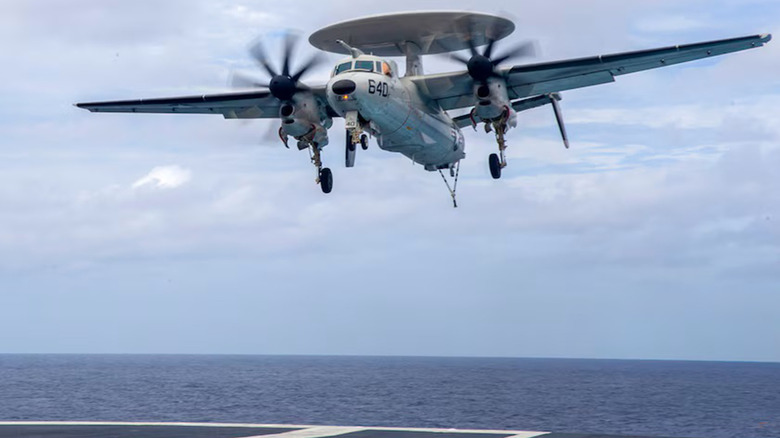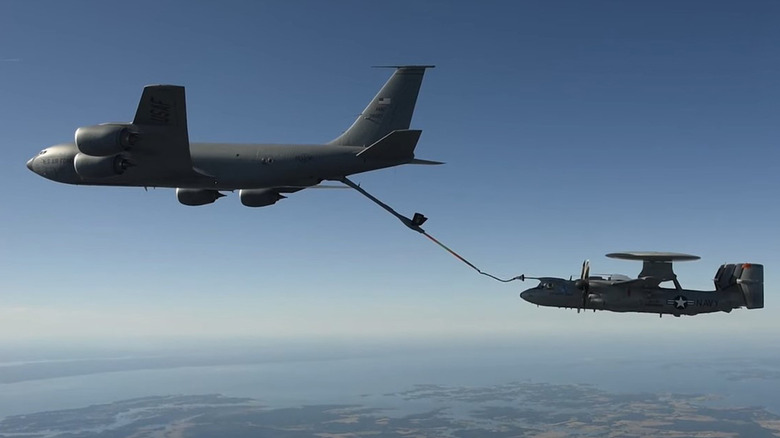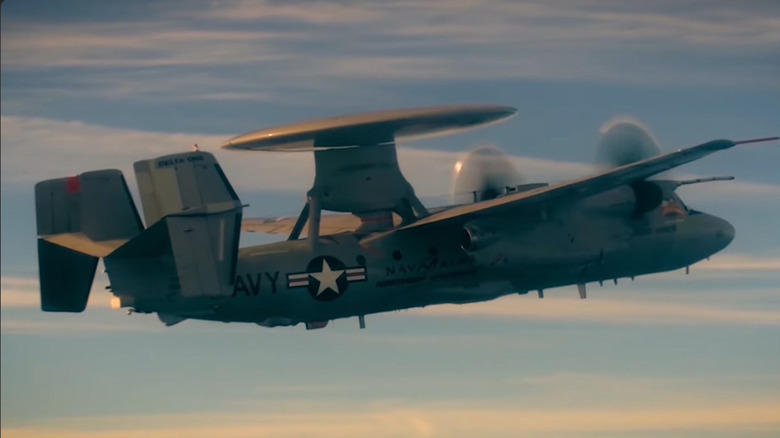The E-2D Advanced Hawkeye Aircraft Has Impressive Aerial Refueling Abilities - Here's How It Works
The U.S. Navy's E-2 Advanced Hawkeye is a carrier-borne Airborne Command and Control aircraft that has acted as a nerve center and protective umbrella for carrier groups for decades. Although the aircraft is more commonly associated with aircraft carriers, its manufacturer — Northrop Grumman — also notes its effectiveness as a command and control aircraft for landlocked nations.
The first E-2 prototype took to the air in 1960; since then, the aircraft has continually evolved, culminating in the latest E-2D variant, which made its first carrier landing on the USS Harry Truman in February 2011. It's also one of the propeller-driven aircraft still used by the U.S. military. The key mission for this aircraft is to defend carrier groups against enemy threats, and one aspect that is crucial in achieving this is its ability to function for extended durations. The addition of mid-air refueling has lengthened this duration. According to NAVAIR, the E-2D Advanced Hawkeye reached initial capability for aerial refueling in fiscal year 2020. This innovation has extended the Hawkeye's maximum mission duration to up to nine hours.
While the latest E-2D Hawkeye is bursting full of advanced electronics, including an all-weather UHF band radar with 360-degree coverage, its ability to refuel in mid-air was an important, officially sanctioned part of the aircraft's upgrade program. The mid-air refueling of Hawkeye aircraft is also under continual development. A point ably demonstrated when a collaboration between the French military and the U.S. Navy saw the Hawkeye aerially refueled by three French tankers.
Refueling the Hawkeye
The $226.7 million contract to engineer mid-air refueling into the E-2D was awarded to Northrop Grumman in 2013. By July 2017, an E-2D received 162 pounds of fuel from a U.S. Navy KC-130 Hercules in test refueling. This might not be enough fuel to extend a mission meaningfully, but it did prove the concept, and by January 2018, an E-2D received 2,000 pounds of fuel during a test.
There are two main methods of refueling aircraft in mid-air. Mostly, the E-2D uses the probe-and-drogue system. The E-2D has a probe that protrudes from above the cockpit; this is the visible part of the assembly. Beneath the skin of the aircraft, this probe attaches to plumbing that directs the fuel into the fuel tanks. The tanker flies in front of the Hawkeye, trailing a flexible hose at the end of which is the funnel-shaped drogue. The skill of both pilots is key at this stage as the aircraft maneuver until the probe and drogue establish a connection. At this point, the shape of the drogue ensures that the airflow keeps the two components locked tightly enough that a valve allows the fuel to begin flowing.
However, while probe-and-drogue is typically the U.S. Navy's preferred refueling method, the E-2D has also been refueled using the boom method. In this case, a Pennsylvania National Guard KC-135 airborne tanker plane used the boom system to refuel an E-2D in mid-air. This system relies on the boom operator to make the link between the aircraft by guiding the boom onto the E-2D's probe.
The challenges of retrofitting a mid-air refueling system
Retrofitting mid-air refueling capabilities to an aircraft isn't easy. However, it's all in a day's work for the engineers at Northrop Grumman. For starters, installing such a system is far more complex than just squeezing in some extra pipework. Most aircraft with mid-air refueling capabilities are designed from the ground up to accommodate the systems. The engineers at Northrop Grumman had to work out how to integrate this into the production process for new aircraft, as well as to make sure it can be retrofitted to existing aircraft in the fleet. The approach the design team took was to first develop and prove the refueling system on the ground, which helped them to perfect the design faster than is normal for such projects.
The engineering considerations also went deeper than merely adding the refueling plumbing and systems. The engineers also had to adapt the aircraft's software to help the pilots by improving the aircraft's flight characteristics during the refueling process. The comfort of the pilots was also a consideration, with new "fatigue-reducing" seats being designed as part of the package. These also improved the aircrew's field of view, which is critical during refueling. Additionally, the upgrade included formation lights that are designed to help pilots maintain visual awareness and spatial orientation during refueling operations.
For the U.S Navy and other operators of the Hawkeye, the work of these engineers is transformative and can keep these sentinels flying and protecting for far longer.


